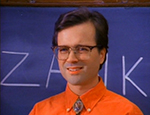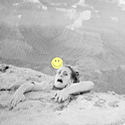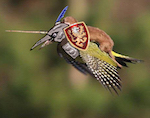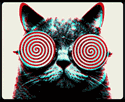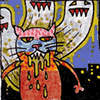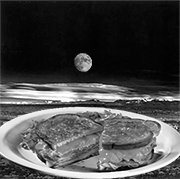|
I'd like to trade my V700 for a 35mm scanner if anyone is interested. Comes with all the holders and the original box.
|
|
|
|

|
| # ? May 2, 2024 09:11 |
|
I've been scanning my negatives in as positive and then inverting and post processing in PS and LR. I am not modifying the tone curve or the histogram on the initial scan whatsoever, and this seems to make sense to me. Having said that, am I correct that the default settings are best when scanning a negative as a positive? Would there be any reason to do otherwise?
|
|
|
|
Default settings are probably fine. Maybe adjust brightness if there's not enough value at one end of the histogram.
|
|
|
|
You want your scanner software to be doing as little as possible to the image. Turn everything off.
|
|
|
|
I remember that someone had a set of Photoshop actions for scanned negatives. I went through a bunch of pages in this and the Film thread but can't see them anywhere. Can someone repost them please?
|
|
|
|
That was me https://www.iamthejeff.com/files/Film%20Editing.atn Scan as positive, crop out frame edges and clone out any really bad dust specs, then apply the filter.
|
|
|
|
What I would really like is a 3D LUT that corrects Portra's tone curve after dMax and dMin have been established, leaving only contrast and color temp as the only necessary adjustments. Somehow I have doubts that a Photoshop action gets me very close to that scenario
|
|
|
|
BANME.sh posted:That was me Awesome, thanks a lot dude.
|
|
|
|
The XKCD Larper posted:What I would really like is a 3D LUT that corrects Portra's tone curve after dMax and dMin have been established, leaving only contrast and color temp as the only necessary adjustments. Somehow I have doubts that a Photoshop action gets me very close to that scenario Buy ColorPerfect.
|
|
|
|
Great, thanks guys for the info and BANME for that atn file. super useful.
|
|
|
|
MrBlandAverage posted:Buy ColorPerfect.
|
|
|
|
Get a cheaper hobby then
|
|
|
|
I wouldn't pay for color perfect if I had all the disposable income in the world. Dude has to hire a UI designer before I'll even touch that steaming pile. It wouldn't be so bad if it was just ugly, but it blatantly goes against just about every software UI convention that exists.
|
|
|
|
BANME.sh posted:I wouldn't pay for color perfect if I had all the disposable income in the world. Dude has to hire a UI designer before I'll even touch that steaming pile. It wouldn't be so bad if it was just ugly, but it blatantly goes against just about every software UI convention that exists. Oh, yes, the UI is awful, which is why I haven't bought it, but it is better than even a 3D LUT. It was part of the workflow of a drum scanner I had the privilege of using for a few weekends and it definitely made color correction fast. That said, my current color workflow is just as fast and is free, so I don't have much incentive to buy ColorPerfect other than perhaps curiosity.
|
|
|
|
BANME.sh posted:I wouldn't pay for color perfect if I had all the disposable income in the world. Dude has to hire a UI designer before I'll even touch that steaming pile. It wouldn't be so bad if it was just ugly, but it blatantly goes against just about every software UI convention that exists. hi I'm silverfast, have we met?
|
|
|
|
So I've been scanning my 120 and have been very happy with the results I'm getting. I've been scanning at (I think) 600dpi for 10" on the long side then resizing down after correcting levels and such in PS. Someone wants a print of one of the scanned shots and the image I have is ~3700x2600 pixels. They're looking to print this around 36"x24" or so, possible a little smaller. They've been using a webapp from a reputable print shop and it's giving them some indication that the resolution of the file is appropriate for a 12"x9" print. I'm guessing I should at this point scan at a higher DPI, or should I leave the DPI at 600 and scan for a larger image? I believe the epson v550 I'm using has a maximum optical resolution of 6400dpi but I know better than to scan at that. Thanks.
|
|
|
|
VelociBacon posted:So I've been scanning my 120 and have been very happy with the results I'm getting. I've been scanning at (I think) 600dpi for 10" on the long side then resizing down after correcting levels and such in PS. Someone wants a print of one of the scanned shots and the image I have is ~3700x2600 pixels. They're looking to print this around 36"x24" or so, possible a little smaller. They've been using a webapp from a reputable print shop and it's giving them some indication that the resolution of the file is appropriate for a 12"x9" print. Epson's have a "real" resolution of roughly 2400dpi so imho the highest scanning res that's worth your time is 3200dpi. This will get you plenty pixels for a print of that size.
|
|
|
|
8th-snype posted:Epson's have a "real" resolution of roughly 2400dpi so imho the highest scanning res that's worth your time is 3200dpi. This will get you plenty pixels for a print of that size. Should I also be setting the output size of the scan to the desired size of the print? Thanks.
|
|
|
|
VelociBacon posted:Should I also be setting the output size of the scan to the desired size of the print? Thanks. That shouldn't matter just the resolution of the file, just like with any digital image.
|
|
|
|
 I used an online tool and got this. Guess I'll try scanning at 3200 and see how it looks.
|
|
|
|
I'm scanning film with my Epson V600 as a positive .tiff file with all the scanner adjustments turned off (EpsonScan in pro mode), then running Banme.sh's actions on them. Then I flatten the image and save it so I can import it into Lightroom (my laptop cries if Ps and Lr are open at the same time). My question is that the colour balance is all over the place after running the actions. Is that normal? The result I get is very blue and not very contrasty. I'm finding that even with quite saturated filmstock like Ektar, I get relatively low-contrast results and getting accurate colours in Lr is very hard. Am I missing something dumb? I'm having to move the tint and temperature controls in Lr almost to the furthest right of each slider just to get something that isn't blue.
|
|
|
|
Helen Highwater posted:I'm scanning film with my Epson V600 as a positive .tiff file with all the scanner adjustments turned off (EpsonScan in pro mode), then running Banme.sh's actions on them. Then I flatten the image and save it so I can import it into Lightroom (my laptop cries if Ps and Lr are open at the same time). My question is that the colour balance is all over the place after running the actions. Is that normal? The result I get is very blue and not very contrasty. I'm finding that even with quite saturated filmstock like Ektar, I get relatively low-contrast results and getting accurate colours in Lr is very hard. That's not normal. Post a scan straight from the scanner and let's see how it looks
|
|
|
|
Invert and set b/w points with a curves adjustment layer in PS. You don't need an action.
|
|
|
|
Seriously. I'm pretty sure that action isn't for Ektar, either. There's also no reason to do the b/w points in an adjustment layer - anything you discard is data you'd be throwing away anyways
|
|
|
|
That's what the action does but with more repeatable accuracy and obviously speed.
|
|
|
|
B/W points won't be consistent outside of a single sheet of film or roll, so I question your claim of "accuracy".
|
|
|
|
You can do some pretty smart things with actions, it's not simply setting a static point on every photo.
|
|
|
|
BANME.sh posted:That's what the action does but with more repeatable accuracy and obviously speed. I used it for a bit. I'm not trying to diminish your abilities or discourage people from automating their workflow process but it was a useful starting point maybe 30% of the time compared to setting the points manually.
|
|
|
|
BANME.sh posted:You can do some pretty smart things with actions, it's not simply setting a static point on every photo. Unless you're dusting beforehand, I'm still not buying it.
|
|
|
|
That's fair, whatever works for you. I've done it the manual way for hundreds and hundreds of scans and I found it frustrating to get a repeatable result photo to photo especially when scanning and correcting an entire roll. I guess if you are shooting LF then you don't have dozens of scans to process at a time, doing it manually and repeatability between frames is not a concern.
|
|
|
|
Even without LF I don't mind doing it per-photo. Why bother trying to manually do each image if you're not going to print it or upload it somewhere? Contact sheets were there for a reason - a way to quickly evaluate what photos you wanted to print. You can have a similar experience just looking at the thumbnails in a scanning program and deciding that you're only going to edit one or two photos per roll. Beyond that, what advantage do you get over just letting your scanning program do the colors for you at that point?
|
|
|
|
I do clone out the large dust spots before, yes. The action is literally an automatic replication of the manual per-channel curves clipping method that gets reposted in this thread time and time again. The end result is the same but it's more repeatable because you are not relying on your own eyes to tell you when to stop pulling that slider. You still have lots of room to tweak and make adjustments afterwards, as opposed to scanner software deciding to clip channels on a whim. Debating the need to scan and correct every photo on 35mm vs MF/LF is beside the point. But if you must know, I take a lot of family and kid photos on film and it's nice to pick and choose the best frame without having to manually correct a dozen shots. This workflow works for me. Anyway here's one example with literally no other corrections done, just the action "out of the box". I googled "film negative scan" and found this example image: http://i.imgur.com/UK3CJH0.jpg  
|
|
|
|
BANME.sh posted:The end result is the same but it's more repeatable because you are not relying on your own eyes to tell you when to stop pulling that slider. I don't use my eyes. 
|
|
|
|
How repeatable.
|
|
|
|
Yes, I hold the alt key to see the clipping pixels, but you're still using your own judgement to determine how many pixels to clip for each photo (do you stop after seeing 1 pixel, or do you let a few of them clip like that annoying video shows?). And if you are doing say, three frames in a row of the same scene, its way easier to let the action do it for you. I get that your workflow works for you and you probably have every cursor movement and mouse click down to muscle memory by now, and that's fine. This worked for me, and other people showed interest in it.
|
|
|
|
BANME.sh posted:Yes, I hold the alt key to see the clipping pixels, but you're still using your own judgement to determine how many pixels to clip for each photo (do you stop after seeing 1 pixel, or do you let a few of them clip like that annoying video shows?). And if you are doing say, three frames in a row of the same scene, its way easier to let the action do it for you. I get that your workflow works for you and you probably have every cursor movement and mouse click down to muscle memory by now, and that's fine. This worked for me, and other people showed interest in it. Doesn't seem very repeatable in Helen Highwater's experience...
|
|
|
|
I ran your action on another random negative I found on google as well as doing the processing by hand. Hmm. I wonder which is which?
|
|
|
|
Don't know why you are so bent on proving me wrong or whatever, but you didn't even crop out the frame borders on that example.
|
|
|
|
That's part of my point - you have to spend time dusting and cropping before you even do the colors. I'm bent on trying to get people in here to actually learn how to correct negatives instead of trying to find an "Easy" solution that's actually not very easy. How much time do you spend rotating (my scanner's holders definitely aren't straight) and cropping each image just to run the action?
|
|
|
|

|
| # ? May 2, 2024 09:11 |
|
I dunno about you guys, but I find it much, much harder to find dust on a negative that isn't inverted/color corrected yet than on one that is, so if dust makes your action fail, it's going to take a lot longer to use than pushing curves points around myself. I wonder if this is Helen Highwater's issue - I've noticed his scans tend to have a lot of dust.
|
|
|




